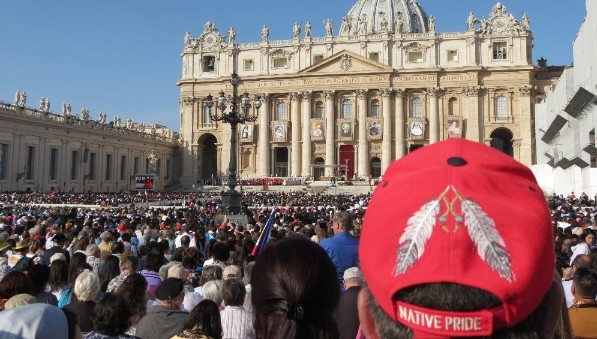
Saint Kateri Tekakwitha: Someone We Can Call Our Own

Thousands of spectators, many wearing flowered lei, feathered headdresses and traditional attire, and others carrying banners and flags assembled at Piazza San Pietro as Pope Benedict XVI presided over a special mass to name seven new saints at the Vatican on October 21; in an effort to bring world religions together for interfaith dialog and commitment for peace in the world. He began, “I extend warm greetings to all of you who fill Saint Peter’s Square, especially the official delegations and the pilgrims who have come to celebrate the seven new saints,” and the crowd cheered when each name was called:
Kateri Tekakwitha also known as “Lilly of the Mohawks,” her reputation for sanctity spread quickly, and in 1980 she was beatified by Pope John Paul II. She was the first Native American to be beatified, and now is the first to be canonized; Marianne Cope, a 19th-century Franciscan nun who cared for leprosy patients in Hawaii; Jacques Berthieu, a 19th-century French Jesuit who was killed by rebels in Madagascar, where he had worked as a missionary; Giovanni Battista Piamarta, an Italian who founded a religious order in 1900 and established a Catholic printing and publishing house in his native Brescia; Maria Carmen Salles y Barangueras, a Spanish nun who founded a religious order to educate children in 1892; and Anna Schaeffer, a 19th century German laywoman who became a model for the sick and suffering after she fell into a boiler and badly burned her legs. The wounds never healed, causing her constant pain.
Benedict praised each of the seven as heroic and courageous examples for the church, calling Kateri an inspiration to indigenous faithful across North America. “May the witness of these new saints … speak today to the whole church, and may their intercession strengthen and sustain her in her mission to proclaim the gospel to the whole world,” he said.
Kateri was born in 1656 in Kanienkehaka (aka Mohawk) territory to an Iroquois father and an Algonquin Christian mother. Her parents and only brother died when she was four during a smallpox epidemic that left her badly scarred and with impaired eyesight. She went to live with her uncle, a Mohawk, who was averse to Christianity. He paired her with an Iroquois boy she was expected to marry; but Kateri rejected all efforts, and committed herself to Christ. She was later baptized by Father Jacques de Lamberville, one of the devoted Jesuit missionaries committed to the evangelization of the Indians in 1676. After becoming Christian she became a model of youthful piety and chastity. She eventually came to live among the fervent Christian Indians of the settlement known as the Mission of St. Francis Xavier, in what was to become known as Canada. Kateri died in 1680 at the age of 24, and according to Jesuit writings, her last spoken words were: “Jesus, I love you.” Her remains are entombed in a church near Montreal.
Speaking in English and French, in honor of Kateri’s Canadian connection, Benedict noted how unusual it was in her Native culture for her to choose to devote herself to the Catholic faith. “May her example help us to live where we are; loving Jesus without denying who we are,” said Benedict. Elizabeth Taylor, Mohawk agrees, “Personally, It’s an affirmation of my Christian faith, with no loss to our traditional way of life.” Benedict continues, “Saint Kateri, protectress of Canada and the first Native American saint, we entrust you to the renewal of the faith in the first nations and in all of North America.”
Chief Thomas Dearhouse, Kahnawake Mohawk, who appeared visibly caught-up in a swirl of emotions said, “Her canonization will be a ceremony steeped in symbolism, and a major first step in healing some painful rifts suffered by Native people and the Catholic Church.” He continues, “Our coming together can only mean something good.” And Vicky Phillips, a St. Regis Mohawk adds, “We now have someone we can call our own.”
However, not all people agree the pope has ultimate power over sainthood. A 50-year old Italian man and practicing Jehovah, who wanted to remain anonymous asserts, “I think the diffusion of Kateri Tekakwitha’s wisdom, or other Christian models such as, Francesco d’Assisi, or William Tyndale, and many other individuals who lavished their lives for God’s knowledge and for people, is admirable. But only God can judge the people, and choose the saints.”
There are many Native Americans who also have objections toward Kateri’s recent sainthood; but that didn’t dampen Melisa Lagasse’s spirit. Lagasse, who is Mohawk thinks the Three Sisters (corn, bean and squash) or companion agriculture is a good way to understand the blending of Native spirituality and Christianity, “These three beautiful sisters are grown together in a single mound of rich black earth for the benefit of their survival; yet each crop is able to retain its own distinctive character while adopting the benefits from the other.” She continues, “Kateri was able to unify Christian and Indian traditions together, and bring sacredness to all life.” Dale Jacobson, Kahnawake Mohawk chimed in and finished Lagasee’s sentence by saying, “That the world can look at and respect.”
Julianne Jennings (Nottoway), Anthropologist